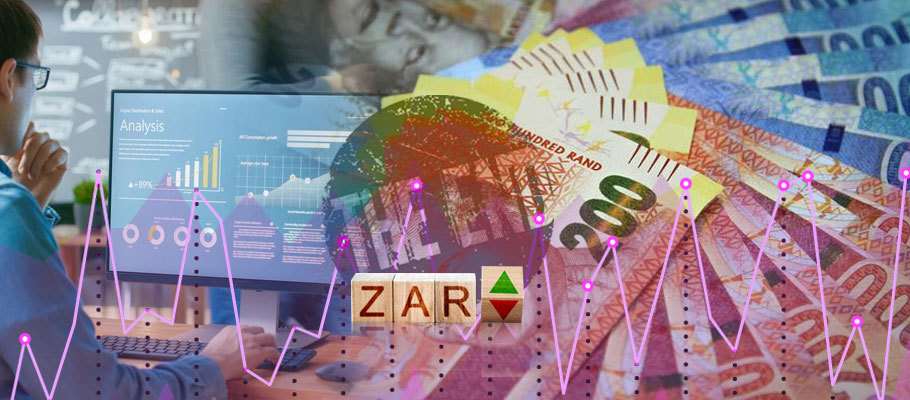
Published: March 23rd, 2022
The South African Rand has made a strong showing throughout the first quarter of 2022, but one of the country's biggest lenders believes support could fade in the coming months.
Analysts at Nedbank have published a market comment that says ZAR has benefited from rising global commodity prices mixed with a stable domestic economy. Those two forces have combined to offer global investors notable returns, but rising oil prices will put Rand under pressure as domestic economic growth starts to fade in Q2 or Q3 2022.
‘Over the past two years, Rand has benefitted from a large trade and current account surplus. We believe that is likely to dissipate and even reverse in the coming months.’
ZAR has appreciated in value by 6.8 per cent for the year-to-date on a trade weighted basis against the fiats of its most important trading partners.
Those gains have surprised some investors given that the Rand sits amongst a list of 'high beta' currencies that normally depreciate in times of rising geopolitical anxiety. Investors have been understandably spooked by Russia's invasion of Ukraine, yet ZAR has found support thanks to South Africa’s reliance on exports of commodities and raw materials.
Nedbank wrote that the Rand is benefitting from the surge in metal prices caused by worries about supply on the back of sanctions on Russian commodity exports.
The New Zealand (NZD) and Australian (AUD) dollars have also benefitted. Like ZAR, they tend to depreciate in times of global investor anxiety. All three are nonetheless finding support amongst the current set of circumstances peculiar to the Russian 'special operation’ in Ukraine.
The Rand is getting an extra shot of resilience from steady growth in the South African economy.
Portfolio flows to Emerging Economies (EM) listed in The Institute of International Finance’s (IIF) database shows that foreign investors have sold most of their emerging market positions, with the exception of South Africa, where equity markets are seeing an inflow of outside money.
Nedbank said that South Africa is giving investors looking for emerging markets exposure a combined package of relative macroeconomic stability compared to Russia, Ukraine, Russia, Turkey, or Brazil, plus deep financial markets, and cheap market valuations.
Central bank policy is also adding support to ZAR, with the South African Reserve Bank (SARB) raising interest rates and increasing returns on assets like Rand-backed bonds.
In January, SARB raised the interest rate for a second time, taking it to four per cent. However, money markets are currently pricing in another 200 basis points worth of increases for the rest of 2022.
Nedbank believes those expectations might be too aggressive, with a chance that many will suffer losses if fewer hikes are actually delivered.
That’s one of the downside risks Nedbank sees for the Rand over coming months. Another is fragile global risk appetite. As investors adjust portfolios in response to a mix of issues that include Ukraine, inflation, supply chain bottlenecks, and rising interest rates, many may seek safety elsewhere.
'The ongoing battle in Ukraine and the disruptions that Russian sanctions are creating in global commodity markets will likely increase risk-off sentiment,’ Nedbank says. ‘That muddies the outlook for global growth. The steep rate-raising path indicated by the US Fed will also test risk appetites through the remainder of 2022’.
Mitigating those concerns somewhat, Nedbank also believes South Africa's export prices could be more resilient than expected if rising risk-off sentiment pushes investors into safe-haven investments like precious metals, where the country also enjoys large exports.
On the downside, South Africa is a net energy importer and the upward spike of crude oil prices could chip away at its export advantages.
Nedbank says crude oil and refined petroleum amount to nearly 17 per cent of South Africa’s total imports. The country can also expect to feel the pinch of higher energy prices and rising inflation on capital goods due to supply chain problems.
'For that reason, we see import prices rising at a faster pace than those of exports. That will have a negative impact on South Africa's trade balance’.
Nedbank is forecasting economic growth of 1.6 per cent for 2022, however a progressively less favourable global economy is expected to catch up with ZAR later in the year.
Nedbank thinks the Rand will trade around 15.14 against the Greenback by mid-year, while the Pound to Rand rate is forecast to trade at 20.21. ZAR is expected to trade at 16.67 against the Euro by year’s end.
The Rand’s multi-month record of outperformance took a temporary knock early in March 2022, when the knock-on effects of the Ukraine conflict halted the downtrends in pairs like USD/ZAR and GBP/ZAR.
The Rand had been on the up against Sterling, the Greenback, and other G10 currencies in the period between December 2021 and February 2022. The Russian action in Ukraine caused the downtrends in USD/ZAR and GBP/ZAR to stall between Tuesday 1st March and Friday 4th March (2022).
The ensuing shock to global markets has spurred numerous bouts of short-term rate volatility in March. However, the Rand has held its ground better than most.
Even in the early March blip it managed to post mild gains over the Pound, Dollar and Euro in overall terms. The losses it sustained were in pairs with other commodity currencies that experienced less negative impact from side-effects of the conflict like surging oil and gas prices.
'The boiling rally in oil prices have pushed prices towards USD 120 a barrel and beyond as buyers shifted away from Russian crude in response to sanctions,’ said Nedbank.